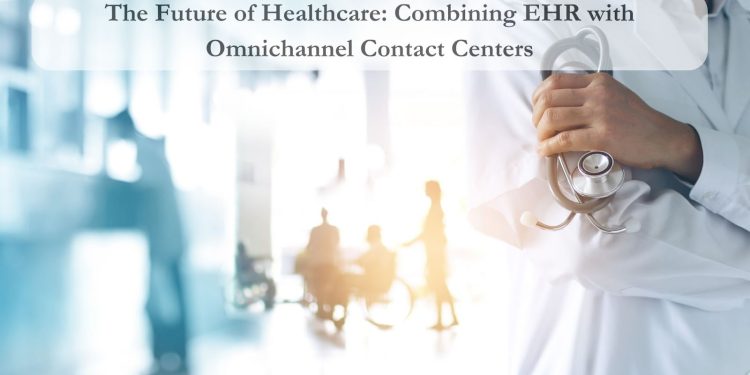The COVID-19 pandemic put healthcare systems under the microscope, revealing their capacity to pivot rapidly. A 2022 patient survey found that 76% now expect healthcare organizations to offer digital access through text, email, chat, and more.
This demand for omnichannel convenience is catalyzing a seismic shift in healthcare operations and patient interactions. Central to this transformation is synthesizing electronic health records (EHRs) with omnichannel contact centers.
Integrating these systems is foundational to the digital dexterity needed in today’s healthcare environment. Organizations able to nimbly adapt their technology infrastructure and channels will be best positioned to meet rising patient expectations.
Though the undertaking requires investment and effort, the omnichannel path promises a more coordinated, satisfying patient experience.
Table of Contents
The Evolution of EHR and Omnichannel Contact Centers
The rise of EHR over the past decade gave healthcare providers an invaluable tool to digitize patient health information. However, EHR alone is not enough to deliver convenient, personalized care in today’s digital-first world.
This is where omnichannel contact centers come in. As defined by Becker’s Health IT, an omnichannel approach provides “a seamless healthcare experience for patients across the entire care continuum.”
The adoption of omnichannel interaction services in healthcare brings significant benefits to both institutions and patients. In recent times, healthcare organizations have seen increased patient satisfaction after implementing omnichannel capabilities.
The ongoing health pandemic caused by coronavirus disease has further emphasized the need for providers to offer seamless personalized experiences through multiple access channels.
Many organizations are finding the best call center integration for Oracle service cloud that offers robust omnichannel capabilities that seamlessly connect with major EHR systems effectively. This allows healthcare organizations to bridge clinical and consumer realms for coordinated patient care.
Benefits of Integrating EHR With Omnichannel Contact Centers
The ultimate goal of an omnichannel strategy in healthcare is to improve patient engagement, increase access to care, and reduce costs while enhancing communication and collaboration among providers.
McKinsey estimates that an integrated digital care model could result in up to $265 billion in annual healthcare savings by 2025.
The adoption of an omnichannel approach can lead to new business growth and increased patient engagement. A study found that millennials prefer texting a healthcare provider rather than calling. Offering digital communication channels caters to patient preferences.
Data Source: Software Advice
Additional benefits of EHR and omnichannel integration include:
- Increased Convenience and Access: Patients can resolve healthcare needs anytime, anywhere via phone, live chat, text, and more.
- Improved Care Coordination: Streamlined communication between patients and providers enables better follow-ups and care transitions.
- Enhanced Patient Experience: Meeting patients on their channel of choice fosters satisfaction and loyalty.
- Richer Data Insights: Integrated systems capture detailed patient interaction data to inform service improvements.
- Higher Staff Productivity: Automation of mundane tasks allows staff to focus on value-added work.
- Reduced Wait Times: Intelligent call routing and appointment management decrease delays.
- Lower Costs: Self-service options through virtual agents reduce expensive in-person visits.
As these benefits demonstrate, integrating EHR with omnichannel contact centers has the potential to profoundly impact healthcare delivery now and in the future.
Challenges and Solutions in the Integration Process
The path to unified EHR and omnichannel systems comes with hurdles that healthcare organizations must carefully navigate:
1. The Cost Conundrum – Mitigate the significant upfront investment required by taking a gradual approach, starting with affordable high-impact digital channels.
2. The Workflow Puzzle – Reconfiguring complex workflows requires in-depth pre- and post-integration analysis to get the pieces right.
4. Data Dilemmas – Syncing disjointed datasets demands specialized expertise. Partner with integration pros to enable seamless data flows.
5. The Change Management Challenge – Getting staff and patients onboard requires clear communication and training on the benefits of integration.
6. Staying Compliant – Updated protocols are needed to keep new channels HIPAA compliant. Legal teams should guide evaluations.
7. Crunching the Numbers – Large integrated datasets need dedicated analytics staff. Leverage AI and machine learning to extract insights.
8. Monitoring for Success – Continuously gather patient feedback through surveys and channel performance data. Adjust based on real-time input.
With thoughtful planning, healthcare organizations can overcome these hurdles on the pathway to integrated systems and more coordinated patient care.
Integrating EHR and Omnichannel: Key Recommendations
The Path to Seamless Healthcare Integration
1. Conduct Thorough Assessments – Perform in-depth analysis before and after integration to quantify the impact on costs, operations, and patient satisfaction
2. Take a Gradual Approach – Manage scope and investment by taking an incremental, step-by-step approach to integration
3. Solidify Data Governance – Develop strong data governance and cybersecurity protocols early in the integration process
4. Support Users with Training and Change Management – Provide extensive training and change management support to equip staff for the integration
5. Continuously Gather Patient Feedback – Collect real-time patient feedback through surveys, interviews, and usage monitoring to refine integration
6. Leverage AI and Analytics – Use AI, machine learning, and analytics to extract key insights from integrated data
7. Start With High-Demand Digital Channels – Demonstrate quick wins by first integrating popular digital channels like text and chat
8. Align Compliance Requirements – Work closely with legal and compliance teams to meet all regulatory needs
9. Partner With Specialized Vendors – Consider partnering with specialized integration and technology vendors when beneficial
10. Share Best Practices – Share results and best practices with industry peers to collectively advance integration efforts
The Future With EHR and Omnichannel United
Looking ahead, the fusion of convenient omnichannel access with rich EHR data will continue revolutionizing healthcare experiences for all stakeholders. Patients will engage in their care on their terms through their channels of choice. Providers will efficiently coordinate entire care journeys as patient data seamlessly flows through integrated systems.
While change brings challenges, those who embrace this change with courage and resolve will emerge as leaders in healthcare’s digital future. As Niccolo Machiavelli once said, “There is nothing more difficult to take in hand, more perilous to conduct, or more uncertain in its success than to take the lead in the introduction of a new order of things”.
By integrating EHRs and omnichannel capabilities, healthcare organizations can successfully introduce a new order of digital-first care.

Bottom Line
The digital transformation of healthcare is accelerating, and pioneering organizations will steer the industry’s course. For providers and systems eager to thrive in the impending landscape, the window to execute an integrated EHR and omnichannel strategy is open but narrowing.
Now is the time to architect the infrastructure that seamlessly syncs clinical data with consumer-grade access. Equipped with rich insights and multifaceted care options, patients are empowered and providers enabled.
The result is a bold vision materializing, coordinated care tailored to each individual, offered conveniently through their channel of choice. By digitally integrating critical capabilities today, healthcare organizations can bring this consumer-centric model to life, making quality care more accessible and affordable at a pivotal juncture.
Frequently Asked Questions
1. How can omnichannel healthcare address the disparities in health outcomes across different localities?
Omnichannel healthcare helps address geographic disparities by providing underserved communities with more convenient access to providers through digital channels. Rural patients can consult doctors via video visits. The homeless can obtain care through text-based outreach.
2. What are the potential challenges health systems might face when integrating EHR with omnichannel contact centers?
Top challenges include technology costs, complex workflow changes, data integration difficulties, compliance needs, analyzing new datasets, evaluation of services, and change management. Taking an incremental approach and getting buy-in across teams helps overcome these hurdles.
3. How can payers and health systems collaboratively leverage omnichannel healthcare to improve patient outcomes and reduce costs?
Payers and health systems can coordinate to implement compatible omnichannel platforms, share patient data seamlessly, design flexible coverage policies around digital services, and incentivize integrated care models that deliver savings and better outcomes.


 Home
Home










